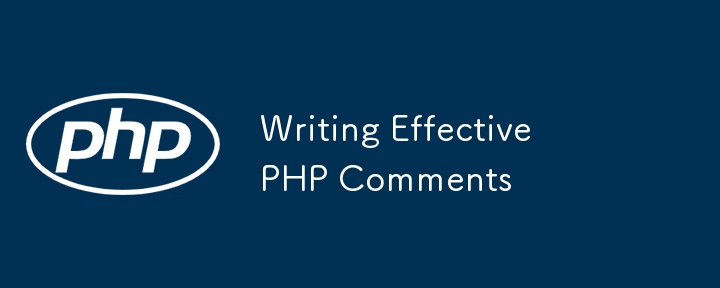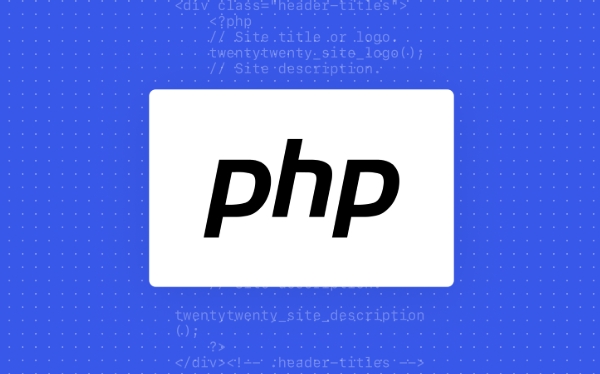Writing Effective PHP Comments
Comments cannot be careless because they want to explain the reasons for the existence of the code rather than the functions, such as compatibility with old interfaces or third-party restrictions, otherwise people who read the code can only rely on guessing. The areas that must be commented include complex conditional judgments, special error handling logic, and temporary bypass restrictions. A more practical way to write comments is to select single-line comments or block comments based on the scene. Use document block comments to explain parameters and return values at the beginning of functions, classes, and files, and keep comments updated. For complex logic, you can add a line to the previous one to summarize the overall intention. At the same time, do not use comments to seal code, but use version control tools.

Writing PHP comments is actually quite important, but many people don’t do it properly. Comments are not just written just a few sentences. The key is to help others (or yourself in the future) understand the code faster.

Why can't comments be sloppy?
When many novices write comments, they like to write ambiguous content like "this function does something", which is actually equivalent to not writing it. A good comment should explain why this code exists, not what it is doing . for example:
- This logic is for compatibility with old versions of interfaces
- A certain parameter needs to be handled specifically because of the limitations of third-party libraries
If this information is not written out, people who read the code can only guess.

Where must I add comments?
Some code blocks are recommended to add comments even if they look very clear, such as:
- Complex conditional judgment, especially when nesting multi-layer if
- Special error handling logic
- Limits that need to be temporarily bypassed (for example, a patch is applied)
For example, if you have a piece of code that processes time format conversion, just looking at the code may know that it is converting formats, but don't know why you must use strtotime() instead of directly DateTime object. At this time, a comment can save a lot of doubts.

How to write comments more practical?
There are two commonly used annotation methods in PHP: single-line comment // and block comment /* */ . Recommended selection based on the scene:
- Use a brief description
// - Functions, classes, and files are commented with document blocks at the beginning, such as:
/** * Process user login logic, including third-party verification process* * @param string $username Username * @param string $password Password * @return bool Login is successful*/
Some other tips:
- Don't use comments to "seal" large pieces of code, use version control tools instead
- Keep comments updated, don't let old comments mislead people
- If the logic is complicated, you can add a line of comments to summarize the overall intention
Last point: Don't be afraid to write a few more sentences
Sometimes you will think, "Is this code not obvious?" But when you come back to see it in a few months, you may have to think about it for a long time. Instead of regretting it afterwards, it is better to spend a few more seconds writing it out. Especially for some "pit points" or "non-standard practices", even if you write one or two more sentences, it will be very helpful to later generations.
Basically, that's all. Comments seem small, but it's really a waste of things if you can't do it well.
The above is the detailed content of Writing Effective PHP Comments. For more information, please follow other related articles on the PHP Chinese website!

Hot AI Tools

Undress AI Tool
Undress images for free

Undresser.AI Undress
AI-powered app for creating realistic nude photos

AI Clothes Remover
Online AI tool for removing clothes from photos.

ArtGPT
AI image generator for creative art from text prompts.

Stock Market GPT
AI powered investment research for smarter decisions

Hot Article

Hot Tools

Notepad++7.3.1
Easy-to-use and free code editor

SublimeText3 Chinese version
Chinese version, very easy to use

Zend Studio 13.0.1
Powerful PHP integrated development environment

Dreamweaver CS6
Visual web development tools

SublimeText3 Mac version
God-level code editing software (SublimeText3)

Hot Topics
 1658
1658
 276
276
 How to add a watermark to an image in php
Sep 15, 2025 am 03:26 AM
How to add a watermark to an image in php
Sep 15, 2025 am 03:26 AM
Use PHP's GD library to add watermarks to images. First load the original image and watermark (text or image), then use imagecopy() or imagettftext() to merge, and finally save the output. Support JPEG, PNG and other formats, pay attention to handling transparency and font paths, and ensure that GD extension is enabled.
 How to prevent XSS (Cross-Site Scripting) attacks in PHP?
Sep 15, 2025 am 12:10 AM
How to prevent XSS (Cross-Site Scripting) attacks in PHP?
Sep 15, 2025 am 12:10 AM
PreventXSSbyescapingoutputwithhtmlspecialchars()orjson_encode(),validatinginputusingfilter_var(),applyingCSPheaders,andusingsecureframeworkslikeLaravel.
 How to make an API call using cURL in PHP?
Sep 15, 2025 am 05:16 AM
How to make an API call using cURL in PHP?
Sep 15, 2025 am 05:16 AM
InitializecURLwithcurl_init(),setoptionslikeURL,method,andheaders,senddatausingPOSTorcustommethods,handleresponseviacurl_exec(),checkerrorswithcurl_error(),retrievestatususingcurl_getinfo(),decodeJSONresponse,andclosewithcurl_close().
 How to convert an object to an array in PHP?
Sep 14, 2025 am 03:14 AM
How to convert an object to an array in PHP?
Sep 14, 2025 am 03:14 AM
Use (array) to convert simple objects into arrays. If they contain private or protected properties, the key names will have special characters; for nested objects, recursive functions should be used to traverse the conversion to ensure that all hierarchical objects become associative arrays.
 How to work with environment variables in PHP?
Sep 15, 2025 am 03:55 AM
How to work with environment variables in PHP?
Sep 15, 2025 am 03:55 AM
Usegetenv()toreadenvironmentvariablesandvlucas/phpdotenvtoload.envfilesindevelopment;storesensitivedatalikeAPIkeysoutsidecode,nevercommit.envtoversioncontrol,anduseactualenvironmentvariablesinproductionforsecurity.
 How to get POST data in PHP?
Sep 16, 2025 am 01:47 AM
How to get POST data in PHP?
Sep 16, 2025 am 01:47 AM
Use the $_POST hyperglobal array to obtain POST data, read the value through the form name attribute, and use a foreach loop when processing array input, so that the data needs to be verified and filtered to prevent XSS.
 Qushu.com downbook update portal_Dangshu.com bookdown e-book download
Sep 16, 2025 am 10:18 AM
Qushu.com downbook update portal_Dangshu.com bookdown e-book download
Sep 16, 2025 am 10:18 AM
The latest access address of Qushu.com downbook is https://downbook.cc/. The platform provides rich e-book resources, covering a variety of topics, supports customized reading settings, night mode, offline downloads and synchronized reading progress across devices, ensuring that users have a smooth and comfortable reading experience.
 How to add a value to the beginning of an array in PHP?
Sep 14, 2025 am 03:18 AM
How to add a value to the beginning of an array in PHP?
Sep 14, 2025 am 03:18 AM
Use the array_unshift() function to add values at the beginning of a PHP array, which accepts an array and one or more elements to be inserted, returning the new length of the array after insertion. For example, array_unshift($fruits,'orange') inserts 'orange' into the beginning of the $fruits array and automatically re-indexes the numeric keys to keep the associated key unchanged and the original array is modified.





